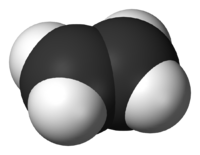
Photo from wikipedia
Reductive cleavage of alkenes is rarely reported in synthetic chemistry. Here we report a unique H2S-mediated reductive cleavage of C[double bond, length as m-dash]C bonds under mild conditions, which is… Click to show full abstract
Reductive cleavage of alkenes is rarely reported in synthetic chemistry. Here we report a unique H2S-mediated reductive cleavage of C[double bond, length as m-dash]C bonds under mild conditions, which is a successful new strategy for the design of probes for effective sensing of H2S with turn-on dual-color fluorescence. A short series of phenothiazine ethylidene malononitrile derivatives were shown to react with H2S, via reductive cleavage of C[double bond, length as m-dash]C bonds with intramolecular cyclization reactions to form thiophene rings. Enlightened by this new reaction mechanism, four effective probes with turn-off to turn-on fluorescence switches were successfully applied for sensing H2S, an important gaseous signalling molecule in living systems, among which PTZ-P4 exhibited two fluorescent colors after reductive cleavage. The dual-color probe was applied for imaging endogenous H2S and showed distinct differences in brightness in living C. elegans for wild type N2, glp-1 (e2144) mutants (higher levels of endogenous H2S), and cth-1 (ok3319) mutants (lower levels of endogenous H2S). The discovery of H2S-mediated reductive cleavage of C[double bond, length as m-dash]C bonds is expected to be valuable for chemical synthesis, theoretical studies, and the design of new fluorescent H2S probes.
Journal Title: Chemical science
Year Published: 2018
Link to full text (if available)
Share on Social Media: Sign Up to like & get
recommendations!